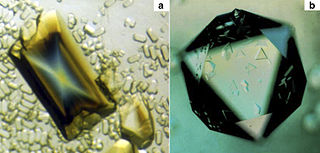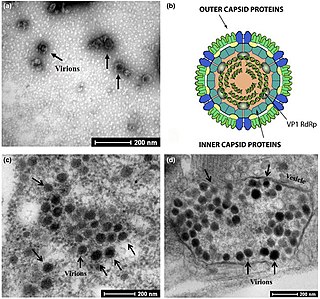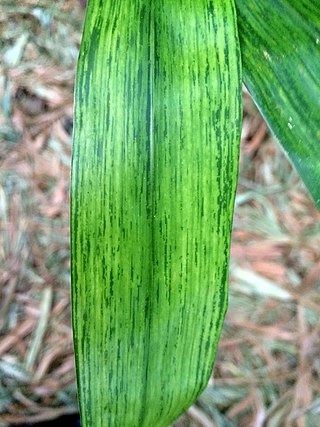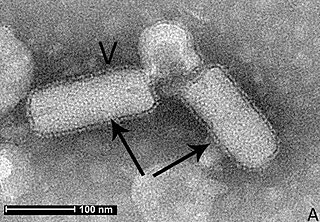
A satellite is a subviral agent that depends on the coinfection of a host cell with a helper virus for its replication. Satellites can be divided into two major classes: satellite viruses and satellite nucleic acids. Satellite viruses, which are most commonly associated with plants, are also found in mammals, arthropods, and bacteria. They encode structural proteins to enclose their genetic material, which are therefore distinct from the structural proteins of their helper viruses. Satellite nucleic acids, in contrast, do not encode their own structural proteins, but instead are encapsulated by proteins encoded by their helper viruses. The genomes of satellites range upward from 359 nucleotides in length for satellite tobacco ringspot virus RNA (STobRV).

Geminiviridae is a family of plant viruses that encode their genetic information on a circular genome of single-stranded (ss) DNA. There are 520 species in this family, assigned to 14 genera. Diseases associated with this family include: bright yellow mosaic, yellow mosaic, yellow mottle, leaf curling, stunting, streaks, reduced yields. They have single-stranded circular DNA genomes encoding genes that diverge in both directions from a virion strand origin of replication. According to the Baltimore classification they are considered class II viruses. It is the largest known family of single stranded DNA viruses.

Potyvirus is a genus of positive-strand RNA viruses in the family Potyviridae. Plants serve as natural hosts. Like begomoviruses, members of this genus may cause significant losses in agricultural, pastoral, horticultural, and ornamental crops. More than 200 species of aphids spread potyviruses, and most are from the subfamily Aphidinae. The genus contains 190 species and potyviruses account for about thirty percent of all currently known plant viruses.

Begomovirus is a genus of viruses, in the family Geminiviridae. They are plant viruses that as a group have a very wide host range, infecting dicotyledonous plants. Worldwide they are responsible for a considerable amount of economic damage to many important crops such as tomatoes, beans, squash, cassava and cotton. There are 445 species in this genus.
Tenuivirus is a plant virus genus belonging to Phenuiviridae family in the order Bunyavirales. These plant viruses cause diseases in their host plants. Typical symptoms are chlorotic stripes on the affected leaves. This group of viruses make viral inclusions in infected cells which can be used to diagnose infection.

Maize streak virus (MSV) is a virus primarily known for causing maize streak disease (MSD) in its major host, and which also infects over 80 wild and domesticated grasses. It is an insect-transmitted pathogen of maize in the genus Mastrevirus of the family Geminiviridae that is endemic in sub-Saharan Africa and neighbouring Indian Ocean island territories such as Madagascar, Mauritius and La Reunion. The A-strain of MSV (MSV-A) causes sporadic maize streak disease epidemics throughout the maize-growing regions of Africa. MSV was first described by the South African entomologist Claude Fuller who referred to it in a 1901 report as "mealie variegation".

Fijivirus is a genus of double-stranded RNA viruses in the family Reoviridae and subfamily Spinareovirinae. Plants serve as natural hosts. Diseases associated with this genus include: galls (tumours) in infected plants and Fiji disease, with severe stunting, deformation and death. The group name derives from Fiji island the place where the first virus was isolated. There are nine species in this genus.

Maize dwarf mosaic virus (MDMV) is a pathogenic plant virus of the family Potyviridae. Depending on the corn plant’s growth stage, the virus can have severe implications to the corn plant’s development which can also result in economic consequences to the producer of the crop.
Panicum mosaic virus (PMV) is a positive-sense single-stranded RNA viral pathogen that infects plant species in the panicoid tribe of the grass family, Poaceae. The pathogen was first identified in Kansas in 1953 and most commonly causes disease on select cultivars of turf grass, switchgrass, and millet. The disease most commonly associated with the panicum mosaic virus pathogen is St. Augustine Decline Syndrome, which infects species of turf grass and causes chlorotic mottling. In addition to St. Augustine Decline, panicum mosaic virus is responsible for chlorotic streaking and mild green mosaicking in select cultivars of switchgrass and millet.

Sugarcane mosaic virus (SCMV) is a plant pathogenic virus of the family Potyviridae. The virus was first noticed in Puerto Rico in 1916 and spread rapidly throughout the southern United States in the early 1920s. SCMV is of great concern because of the high economic impact it has on sugarcane and maize.

Ilarvirus is a genus of positive-strand RNA viruses in the family Bromoviridae. Plants serve as natural hosts. There are 22 species in this genus.

Carlavirus, formerly known as the "Carnation latent virus group", is a genus of viruses in the order Tymovirales, in the family Betaflexiviridae. Plants serve as natural hosts. There are 53 species in this genus. Diseases associated with this genus include: mosaic and ringspot symptoms.

Bamboo mosaic virus (BaMV) is a plant pathogenic virus in the genus Potexvirus and the family Alphaflexiviridae. BaMV is a filamentous, flexuous rod, 490 nm in length and 15 nm in width. The virus has been fully sequenced and it is 6366 nucleotides long.
Maize lethal necrosis disease is a viral disease affecting maize (corn) predominantly in East Africa, Southeast Asia and South America, which was recognised in 2010. It is caused by simultaneous infection with two viruses, MCMoV and any of several Potyviridae.

Badnavirus is a genus of viruses, in the family Caulimoviridae order Ortervirales. Plants serve as natural hosts. There are 67 species in this genus. Diseases associated with this genus include: CSSV: leaf chlorosis, root necrosis, red vein banding in young leaves, small mottled pods, and stem/root swelling followed by die-back. Infection decreases yield by 25% within one year, 50% within two years and usually kills trees within 3–4 years.

Cytorhabdovirus is a genus of viruses in the family Rhabdoviridae, order Mononegavirales. Plants serve as natural hosts.
Polerovirus is a genus of viruses, in the family Solemoviridae. Plants serve as natural hosts. There are 26 species in this genus. Diseases associated with this genus include: PLRV causes prominent rolling of the leaves of potato and a stiff upright habit of the plants; necrosis of the phloem and accumulation of carbohydrates in the leaves.

Solemoviridae is a family of non-enveloped, positive-strand RNA viruses which infect plants. Solemoviridae is a member of the order Sobelivirales.












